The Leopard Man (1943)
Directed by: Jacques Tourneur
Written by: Ardel Wray, Cornell Woolrich, Edward Dein
Starring: Dennis O'Keefe, Isabel Jewell, Jean Brooks, Margo
USA
AVAILABLE ON BLU-RAY [REGION ‘A’ ONLY] AND DVD
RUNNING TIME: 65 mins
REVIEWED BY: Dr Lenera
In New Mexico, Jerry Manning hires a leopard as a publicity stunt for his night-club performing girlfriend, Kiki. Her rival at the club, Clo-Clo, not wanting to be upstaged, startles the animal and it escapes the club into the night. Then some killings begin to occur in which the victims are young women and seem to have been mauled to death. However, is it possible that a human is doing the killing and making it to look like the doings of a leopard?.…
I remember in my review of 1946’s The Spiral Staircase I mentioned that one could see perhaps the origins of the slasher movie and/or the giallo in it – but after having just watched this third entry in the Val Lewton-produced series of horror movies which was made three years before, one can see it even more here. I’d swear that the likes of Mario Bava and Dario Argento watched it, even though I don’t believe they publicly mentioned it. Serial killers [if one appreciates that the term hadn’t been invented yet] had been fairly thin on the ground in movies back then but not totally absent, with M probably being the best known example. However, I’d really like to know if a film was made prior to 1943 which spent around half of its running time with victims-to-be of a murderer, showing them doing various things before building up to their deaths. There are times where you almost forget the supposed hero and heroine of the piece. I wouldn’t be surprised if this is one of the reasons it doesn’t seem to have quite as much critical acclaim as the first two Lewtons Cat People and I Walked With A Zombie, though overall I don’t think it quite exists on that high level. That, of course, certainly doesn’t mean that it’s not worthy of much praise. William Friedkin says that it’s one of his favourite films, that it “ has been provoking me consciously and unconsciously for about 45 years now”. Indeed it has some striking scenes of horror which any modern director ought to be jealous of, its structure is virtually avant garde for the time, and the film noir-like photography that seems to be a major feature of these films is beautiful. But a few things do let the side down a bit, most notably the setting. I Walked With A Zombie was able to create a palpable Caribbean atmosphere despite never leaving the studio, but The Leopard Man never for once convinces us that we’re in New Mexico, much of it looking like it’s taking place on a slightly redressed New York set.
Both Cat People and I Walked With A Zombie had made a hell of a lot of money for RKO, and as with other low budget franchises one might wonder why more money wasn’t fed into the next one. However, the studio was largely using these films to make money back from expensive money losers. Seeing as I Walked With A Zombie didn’t quite match Cat People‘s box office, they decided to purchase the rights to Cornel Woolrich’s 1942 novel ‘Black Alibi’ [possibly without even knowing its plot], which began life as a short story entitled ‘The Streets Of Jungle Death’ in 1935. Some seem to think that Woolrich intended it to be adapted for the screen; in any case screenwriters Ardel Wray and Edward Dein changed the setting from “the third largest city south of the Panama Canal” to the American Southwest, toned down the book’s emphasis on the murders just a bit, and wrote a new denouement. Filmed as usual entirely on the RKO backlot, it employed again the services of Dynamite, the black leopard who appeared briefly in Cat People. Critics didn’t like this one much, something which is maybe not a surprise seeing as it was in some ways ahead of its time, though audiences flocked to Lewton horror again and director Jacques Tourneur was promoted to the A-list after this, his next film being the million-dollar budget Days of Glory with Gregory Peck, though he didn’t really flourish in this environment. In 1952, RKO reissued it as the second part of a double feature with King Kong, though cinema-goers keen to see a second creature feature would no doubt have been disappointed. It’s unclear if it was at this time when the film was shorn of six minutes; in any case a cut version became the de facto one until the mid-90s.
The titles occur over part of a street, then we adopt the point of view of the camera as we move towards an open doorway where we can make out a woman dancing in her dressing room, before the camera moves, as if changing its mind, and goes into the dressing room of the woman next door. How many times was this kind of thing done much later on? -yet I haven’t seen it in any film made before this one. The woman on the right is Kiki, and she’s fed up with hearing her neighbour Clo-Clo’s [what names they have] castanets. As she chats with the hatcheck girl, she screams at something which turns out to be a leopard. The animal is in the company of her boyfriend, Jerry, who wants her to add it to her act. Rather rudely and unfairly, she waits until Clo-Clo is doing a dance number, then comes in with the leopard which is of course bound to get people’s attention. One sympathises with Clo-Clo, though it’s unwise of her to wave her castanets at the leopard, causing it to break free and run off. The film then does something very interesting, even if it can be said to link to its opening scene. We see Clo-Clo leave the club and track her walking down a street, hinting to us that she could be in danger, before moving round and fixating on a totally new character, a young girl. It’s as if the camera is playing its own game of chance, perhaps symbolised by a ball suspended above a fountain. You’ll already see though what I mean about it never feeling like we’re in New Mexico – there’s some attempt at cultural flavour, the Mexican characters are never patronised to, and I’m not one of these strange people who thinks that folk of one race should only be played by folk of the same race or very close to it, even in modern films [it’s called acting, darling] – the performers here who are playing Mexicans mostly do a decent job – but it just doesn’t look and feel anywhere near right.
Never mind, we soon get an absolutely brilliant sequence, rich in fear, that is honestly one of the best of its type – yes, it’s that good. Despite it being late, the girl’s mother orders her to go back out and buy some corn meal, telling her that she won’t unlock the door unless she returns with the stuff. She doesn’t want to go, citing her fear of the wild animal roaming the countryside, but mother says that she has too much of an imagination. The nearest shop is locked up and the owner won’t open, so she has to travel further, a route that takes her under a small railway bridge. The wind starts to rustle – rustling wind has never been as eerie – and she’s startled by a hay bail falling out of the darkness before she braves the underside of the bridge and buys what she needs. Returning, she sees two bright eyes looking at her out of the black, though they’re gone when she looks again, then is startled by a train whizzing by in a reprise of the bus from Cat People. She see’s the leopard and flees towards her house. Her mother hears her screaming to be let in but decides to teach her a lesson so doesn’t open the door until growling, her screams and the sight of blood pouring under the door change her mind in a variant on ‘The Boy Who Cried Wolf’. The blood is a surprisingly grim touch for the time, but the whole sequence is a masterclass in how to do this sort of thing. Not that long after is an ‘almost as good’ scene with a girl locked in a cemetery. With all this in what is a 65 minute film, there’s not much time spent on the investigation, which is perhaps just as well seeing as these scenes aren’t very interesting, mainly consisting of Jerry repeatedly saying how a human must be the killer even though he can’t seem to say precisely why, while Dr. Galbraith, once a zoologist but now the owner of a museum of Native American artifacts, can’t seem to make his mind up on the matter. The Native American, Charlee How-Come, who owned the leopard, does give himself up because he often drinks and forgets what he did, but we don’t think it’s actually him for more than a moment.
In fact I hate to say this but I guessed the killer quite early on, something I’m rarely able to do but which I found pretty easy here given the small cast of characters. It’s nice to have an early version of the scene where the killer explains why he or she Did It, but this one is very half baked [SPOILER we’re supposed to believe that the sight of an animal killing a human set the killer off SPOILER END] despite being interestingly set amidst a procession of hooked cloaked figures on the anniversary of a massacre by Conquistadors of Native Americans, a typical ‘enlightened’ Lewton ingredient uncommon for the time. And we’re most definitely in Lewton’s familiar world of gloom and death. Two lovers decide to meet in a graveyard where the keeper, when asked if he’s lonely, replies, “No, I have my friends, but they don’t bother me with talk”. The happiest character seems to be Clo-Clo, who sashays around with her castanets in a somewhat inappropriate manner given that murders are being committed locally, but she also keeps visiting a fortune teller who won’t admit that something nasty is foretold and just pretends that there’s something wrong with her cards. She’s an interesting character, well played by the very charismatic Margio [shortened from – get ready – María Marguerita Guadalupe Teresa Estela Bolado Castilla y O’Donnell], best known as the woman who ruins everything in Lost Horizon but an actress who never became the star she deserved too. By contrast, Jean Brooks isn’t given much to work with as the rather selfish Kiki, even if one appreciates that she has less screen time. And Dennis O’Keefe is a very bland male lead. I know that we’re not always intended to focus too much on the romantic couple in a film like this, but I honestly couldn’t care less about either of them. Of course it’s vaguely possible that this was intentional.
Certain things sort of link together without concrete explanation as to why, like the way all three victims don’t seem to have a live father. I like it when such elements are consciously put just to add another unusual dimension to the proceedings. One of them meets an old man at the club, a man who’s father to another woman but who briefly treats her as if she was his own, even giving her money. She makes it home safe and sound but then realises that she dropped the money in the street and heads back out to find it, thus sealing her fate. The Native American element threatens to become important but remains something which just hovers in the background. Cinematographer Robert de Grasse is not a name even this watcher of as many old movies as new recognised, and a quick look at his resume reveals few notable films, something that makes me wonder if Lewton or Tourneur were more hands on with the photography of these films then is credited. This one most definitely continues the visual style of the first two, with lots of gorgeous use of shadows. Scenes where character’s faces are lit up while otherwise bathed in black are especially striking. And composer Roy Webb really holds back in this one; there’s a flamenco main theme twice heard as a dance and a few moments of drama, but some scenes that you’d expect to have musical backing have none. The one time the romantic strings come in, they’re rather welcome. In the end, there’s a hell of a lot in The Leopard Man to admire, even if Lewton himself wasn’t that keen on it, and even if its 65 minutes don’t feel quite complete and some of them seem a bit rushed, as if the screenplay needed a final pass over. But two of its scenes are among the very best of the horror genre, reaching the poetic heights that scaring the viewer can sometimes achieve. And I feel that it deserves far more credit than it gets for introducing some devices and situations that decades later would become cliches and be done to death.
Rating: 










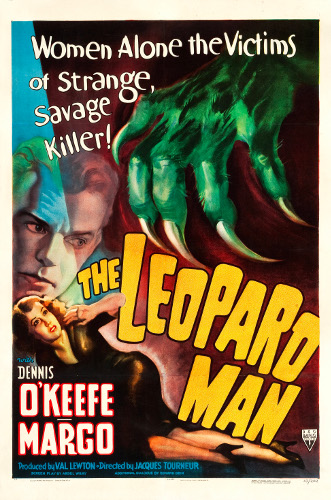
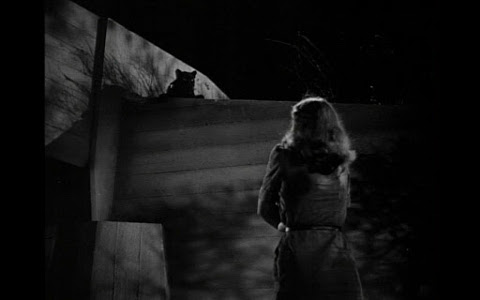
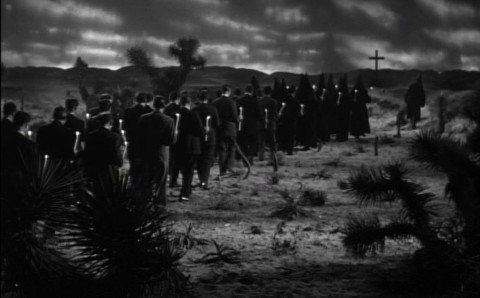

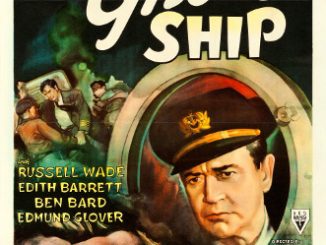

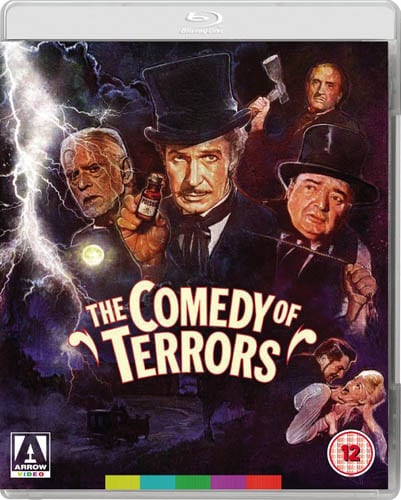
Be the first to comment